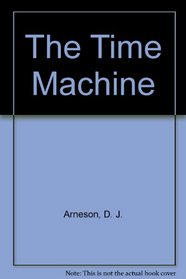One of 'The Young Collector's Illustrated Classics'
Annotation
A scientist invents a time machine and uses it to travel hundreds of thousands of years into the future, where he discovers the childlike Eloi and the hideous underground Morlocks.
From The Critics
School Library Journal
Gr 3-5-- An adaptation of a major portion of H. G. Wells's classic. Rapid-fire short sentences and sentence fragments set the pace and add to the intensity of the action. The Time Traveler and several of his friends are quickly introduced, and then readers are immediately drawn into the future world. The protagonist narrowly survives his initial travels, returning to tell his friends about his harrowing adventures. He sets off once again, leaving the story's end in question--possibly motivating readers to turn to the original for further exploration. Eden's numerous black-and-white drawings are effective in enhancing the narrative. While certainly not a substitute or replacement for the depth and perspectives offered by the real thing, this version lends itself to presentation and discussion with young readers about the genre and about Wells's creative genius in an era long before Steven Spielberg. --Janie Schomberg, Leal Elementary School, Urbana, IL
Annotation
A scientist invents a time machine and uses it to travel hundreds of thousands of years into the future, where he discovers the childlike Eloi and the hideous underground Morlocks.
From The Critics
School Library Journal
Gr 3-5-- An adaptation of a major portion of H. G. Wells's classic. Rapid-fire short sentences and sentence fragments set the pace and add to the intensity of the action. The Time Traveler and several of his friends are quickly introduced, and then readers are immediately drawn into the future world. The protagonist narrowly survives his initial travels, returning to tell his friends about his harrowing adventures. He sets off once again, leaving the story's end in question--possibly motivating readers to turn to the original for further exploration. Eden's numerous black-and-white drawings are effective in enhancing the narrative. While certainly not a substitute or replacement for the depth and perspectives offered by the real thing, this version lends itself to presentation and discussion with young readers about the genre and about Wells's creative genius in an era long before Steven Spielberg. --Janie Schomberg, Leal Elementary School, Urbana, IL




